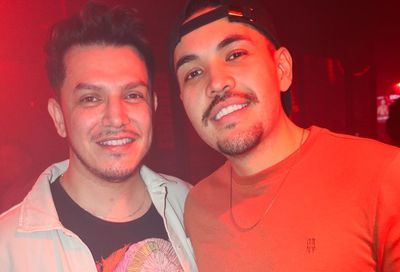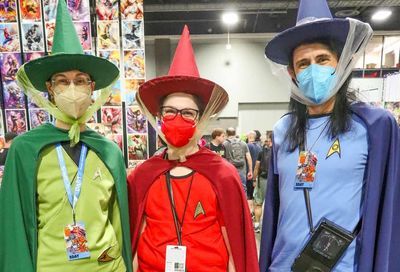Unconcerned about COVID? Virus could potentially ‘infect penis for life’
As vaccines gradually deliver the world from COVID-19, what awaits us on the other side of the curve?

Early in the coronavirus pandemic, Dr. Tom Hope issued a dire warning in this magazine about a potential second wave of infections come the fall.
Hope, of Northwestern University’s Hope Laboratory in Chicago, said that COVID-19 would return “with a vengeance,” and that, with environmental conditions that favor the virus, as well as the onset of flu season, it would be “like a thousand Wuhans releasing virus at the same time.” Reminded of that prediction, Hope says he “couldn’t have called it better.”
On that day in April, 35,386 new cases of coronavirus were confirmed in the U.S., according to World Health Organization data. Now, exactly nine months later, the forewarned spike in cases is undeniably upon us, with over 313,000 new cases reported the day I reconvened with Dr. Hope to discuss the next stages of the pandemic.
“I just think this virus is so predictable, in some ways,” says Hope, once again pointing out how closely the current pandemic curve follows a course similar to that of the 1918 flu epidemic. “It spreads like crazy, and it’s like this weird time machine thing, where it’s all off by two weeks. So what you see happened two weeks ago, and you could stop it all today, but you wouldn’t see any evidence of that for at least two weeks, and that just is very confusing to people.”
Both Hope and Dr. Dave O’Connor, of the University of Wisconsin, have devoted much of their energies and resources this past year to combating that confusion with data. O’Connor’s viral research lab, working to develop and implement better methods of testing for coronavirus, helped design antigen tests using reactive paper cards sold by manufacturers like Abbott Labs. “And what’s neat about these tests is that they can really be performed by anyone without any sort of technical training whatsoever,” O’Connor says.
“They’re limited in that they work best on people who are already symptomatic. But it seemed to us that if you’re thinking about trying to bring testing into schools, then trying to bring this sort of testing that can be done by any school nurse without any sort of molecular biology or fancy technology would be a better alternative. And so we worked really hard over the last couple of months with help from a lot of partners to bring access to this testing to local schools here. So in our county of Dane County, more than 70 schools now have a box of these antigen tests that they can use to test symptomatic members of their school community.”
Teaming up with wife Dr. Shelby O’Connor, who runs her own viral research lab at UW, O’Connor spent much of the summer vigorously pursuing a campaign of testing, testing, testing. “We drove a minivan around where we had put in a portable lab and we were performing testing onsite,” he says.
The couple also contributed very personally to the vaccine development effort, participating as volunteers in AstraZeneca’s trials. That vaccine has not yet been licensed in the U.S., and, as O’Connor notes, “it doesn’t look as good as some of the other vaccines.”
Of the only two licensed vaccine options that are available now in the U.S., Moderna and Pfizer, O’Connor says, “They’re both similar types of vaccines that are based on synthetic parts of the virus’s genetic material. They both work more than 90-percent effectively in terms of preventing people from developing severe disease. And so really, from an end-user perspective, it doesn’t matter [which option you choose]. It’s like an iPhone or a Samsung can both read you your emails. It’s the same general idea.”
Hope agrees. “Moderna or Pfizer. Either one. I think it’s the same thing, the same concept. And the other one is AstraZeneca. I would take that one, too. I think they’re all fairly safe, and we are lucky because this virus is very easy to make a vaccine against.”
More importantly, O’Connor cautions, “If you have been lucky enough to get vaccinated, you have to realize that we’re still in the midst of an absolutely atrocious and awful outbreak. And the only time that vaccine status will become relevant is once we’re out of the woods in our current moment.”
As has become abundantly clear, getting a dose of the vaccine, then hopping a plane to Puerto Vallarta might not be conducive to containing the still-explosive spread of COVID. “No one who is vaccinated knows for sure whether they’re fully protected,” says O’Connor. “No one knows for sure, because the data is still coming in, whether protection from getting severe disease also means that you’re protected from shedding the virus. So people who are vaccinated could still conceivably get infected and could transmit the virus to others. So there is an obligation to continue to take every precaution that you were taking before, so that as a community, we can try to get the total number of infections down as low as possible.”
Another way O’Connor suggests attacking the sky-high infection rate might be a bit more controversial. “My personal belief — and a lot of my colleagues disagree with me on this pretty aggressively — is that getting more people to have a first dose of vaccine is the most important thing. And then we’ll have to just sort out the second dose when the time comes. And the reason that I say that isn’t because I think that there’s data there, because there’s not. But rather I think that we’re going to end up in that position anyway.”
Dr. Hope likewise states an emphatic belief that “we should just start vaccinating people, as many as possible,” he says, describing the current spotty vaccine distribution effort as “a complete failure.” Hope’s father died of complications related to COVID-19 in the fall, soon after having contracted the virus inside his nursing home.
In a bittersweet coda to a stressful year, on what would have been his father’s 90th birthday in December, Hope and his lab made a discovery that could heavily impact how we view the future of this still unfamiliar disease.
For months, working with Dr. Ron Veazey at Tulane University’s School of Medicine, Hope and his team have been studying the lingering effects of coronavirus on organs throughout the body. Using radioactive markers in animal samples, the team found signals of viral infection in some strange and not entirely expected locations — namely, the subjects’ testicles.
“There’s data emerging of that in humans. And so it was a reasonable place to have a signal,” acknowledges Hope. “What really sort of bugged me was the even bigger signal was in the penis, kind of along the upper edge of it, upper surface of it and that wasn’t something that there was an explanation for. The idea of the infection [being] there is not out of line — erectile dysfunction is one of the [consequences] of having been infected and that is out there.”
Examining the tissue under an electron microscope confirmed what the signals had suggested. “In three of the four tissues, in the first slice, we found virus-infected cells, which are very impossible to find,” Hope says.
Now, as the lab prepares to validate its findings, Hope contemplates the significance of their discovery as it might pertain to those who have been infected, as well as those who’ve recovered. He draws a comparison to shingles, noting how, “if you were infected with chickenpox and you get over it, it could come back and cause lots of troubles when you’re 65 or 70.” With COVID-19, “we don’t know what this virus is going to do,” years or decades down the line.
Hope intends to get the message out that prevention and vaccination offer the best protection now from any COVID rebound later. The eye-opening results of his lab studies should help make his case.
“In some way I would like to take these images and share them with my fellow Americans,” he says. “Especially the men, and say, ‘You’ve got a decision to make here. There’s a vaccine that’s really safe. And I would take it in a second. Or you can wonder what an infected penis and balls is going to be like for the rest of your life.’
“I see no risk with the vaccine,” he continues. “I would much rather have the vaccine than be waiting for the bomb to drop from infection on my genitals. And I bet you several people would be inspired by that.”
For more information on the COVID-19 vaccine, and its availability, visit www.cdc.gov/coronavirus.
Read More:
Advocates call on health experts to include LGBTQ people in COVID-19 vaccine rollout
Orthodox rabbi claims COVID-19 vaccine can make people gay
Gay nurse arrested after having sex with COVID-19 patient in hospital toilet
Support Metro Weekly’s Journalism
These are challenging times for news organizations. And yet it’s crucial we stay active and provide vital resources and information to both our local readers and the world. So won’t you please take a moment and consider supporting Metro Weekly with a membership? For as little as $5 a month, you can help ensure Metro Weekly magazine and MetroWeekly.com remain free, viable resources as we provide the best, most diverse, culturally-resonant LGBTQ coverage in both the D.C. region and around the world. Memberships come with exclusive perks and discounts, your own personal digital delivery of each week’s magazine (and an archive), access to our Member's Lounge when it launches this fall, and exclusive members-only items like Metro Weekly Membership Mugs and Tote Bags! Check out all our membership levels here and please join us today!




















You must be logged in to post a comment.